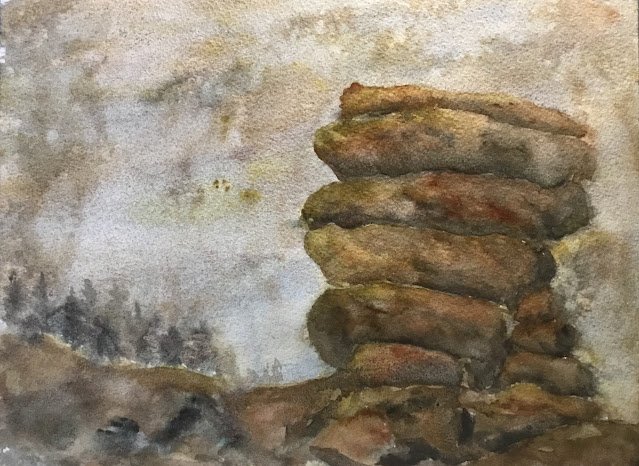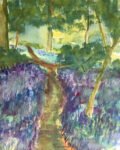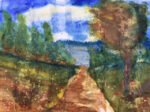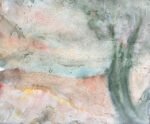30 July 2018 This was based on a picture on a birthday card. It was…

Dragon Path
Preparation of the site for my art studio is now complete, touch wood, so I can go back to painting even if I’m still feeling a little stressed. I gave the supergranulating desert colours an outing, not just because they needed one but also because I thought they might make an easier way back into the swing of things than going for my normal palette.
As subject matter I’ve gone for the Cheesewring on Bodmin Moor, Cornwall, it’s one of those weird piles of balanced but stable looking stones that I can’t resist painting. I was hoping that the desert colours would bring out some of the starkness of the moor. If they did, then maybe the tundra supergranulators could also bring that out in a different painting on another day. Rather than naming this one after the Cheesewring, I’ve named it after the short story by Jacqueline Simson that introduced me to this rock formation. The story can be found in Terror Tales Of Cornwall, presumably available at all good booksellers.
After getting a rough pencil drawing down, the first shape I tackled was the sky. After wetting it (and being careful not to wet the non-sky shapes), I threw in all my five desert colours, not worrying too much about what colours went where. The colours started off a bit too watery, so I charged in more concentrated colour in places, trying at the same time to get some colour variety in a sky that was starting to look a bit too uniformly coloured. I threw on some salt and added some tiny watery spatters to try to bring out some atmosphere as the paint dried.
Then I moved on to the rocks and the background, again using whatever colours I wanted wherever I wanted to but tending to have the darker colours (desert grey and desert green) around the bottom of the rocks and the lighter desert yellow on the tops and on the left. I tried to vary my middle values between desert orange and brown and the darks between desert grey and green. I included the tree line on the left only for compositional reasons – there’s no hill there in reality, let alone a wooded hill.
And then I stopped to look at what I was left with and it wasn’t pretty. The sky was very similar to the rest of the painting in terms of both hues and value. But I believe I managed to solve this problem. The first part of the solution was to distinguish the tones. To do this I applied a glaze of tundra blue over the sky, generally thin but of varying thickness. Things looked better already. The purist in me wasn’t happy about having to use a cold tundra colour with all those warm desert colours but when it comes to a punchup, the artist always wins.
The second step in the solution was to darken all the values in the rocks. To be honest, this should really be thought of as normal painting practice rather than a rescue: it’s only how bad the painting had been looking that made me think of this as a rescue. Anyway, I went in and darkened all the values by adding a new layer. In this second layer, I wanted to harden all the edges, so as well as taking extra care over the ends of the stones, I started by painting alternating stones and finished by going back and painting all those that I’d skipped.
It started raining at one point and I stopped and came indoors, thinking I’d finished. But then I saw that there was one stone that didn’t look right, being much redder than all the others in the Cheesewring. So I headed outside to the canopy hanging over the side of the garage and finished the painting out there without an easel. And that was me done.
And, you know what? I thought this was going to be a disaster and was preparing excuses about being out of practice but I really like this one. The values work, the colours all hang together, the granulation is working even after adding a second layer and there’s a real moodiness coming through. Not only that but it’s feeling professional for reasons that I can’t identify. It’s a winner and it’s up for sale.








Leave a Reply